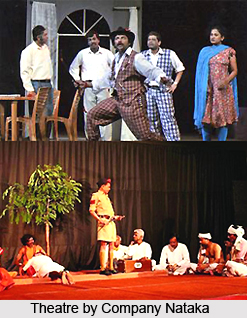 Company Nataka is a popular term referring to two entities of Kannada theatre. This commercial movement has won huge popularity in the first half of the twentieth century, and the genre that was created and refined during the same movement. Generically, Company Nataka is an interesting hybrid of Parsi theatre, Marathi Sangitnatak, and several local performance traditions. From Parsi theatre it took perspective scenery normally five sets of painted curtains, wings, and frills depicting five typical locales and a range of special effects. From Marathi musicals, it learnt how to blend dialogue with song. The blending should be often smoothly and naturally, but sometimes in strange ways like creating unique narrative patterns. Local traditions like the comic vidushaka, the subplots from folk forms, and the method of singing in Carnatic music were also picked up and adapted. The resulting mix continuously catered to a wide variety of audiences, on tour at all-night performances in tents, where the idiom was perfected. Between 1880 and 1900, there were several short-lived attempts to build companies but success came afterwards. Three troupes that made important break through in the 1900s were the Kadasiddeshwara Sangita Nataka Mandali that founded 1901 of Konnurkar. The second one is the Mahalakshmi Prasadika Nataka Mandali in 1903 of Shirahatti Venkobrao, and A. V. Varadachar`s Ratnavali
Company Nataka is a popular term referring to two entities of Kannada theatre. This commercial movement has won huge popularity in the first half of the twentieth century, and the genre that was created and refined during the same movement. Generically, Company Nataka is an interesting hybrid of Parsi theatre, Marathi Sangitnatak, and several local performance traditions. From Parsi theatre it took perspective scenery normally five sets of painted curtains, wings, and frills depicting five typical locales and a range of special effects. From Marathi musicals, it learnt how to blend dialogue with song. The blending should be often smoothly and naturally, but sometimes in strange ways like creating unique narrative patterns. Local traditions like the comic vidushaka, the subplots from folk forms, and the method of singing in Carnatic music were also picked up and adapted. The resulting mix continuously catered to a wide variety of audiences, on tour at all-night performances in tents, where the idiom was perfected. Between 1880 and 1900, there were several short-lived attempts to build companies but success came afterwards. Three troupes that made important break through in the 1900s were the Kadasiddeshwara Sangita Nataka Mandali that founded 1901 of Konnurkar. The second one is the Mahalakshmi Prasadika Nataka Mandali in 1903 of Shirahatti Venkobrao, and A. V. Varadachar`s Ratnavali
Theatrical Company established in 1904. The actor-manager Gubbi Veeranna led the famous Gubbi Channabasaveswara Nataka Sangha from 1917, with which the form reached its climactic years. Other companies which contributed significantly to the movement before Independence were Halageri Company in 1912, Garuda Sadasivarao`s Dattatreya Sangita Nataka Mandali in 1916, Amba Prasadita Nataka Mandali in 1919, Mohammed Peer`s Chandrakala Nataka Mandali in 1930, Vamanrao Master`s Vishwagunadarsha Nataka Mandali in 1931, and K. Hirannaiah`s Hirannaiah Mitra Mandali in 1942.
The plays were mainly mythological, sprinkled with Urdu and Hindi vocabulary, and relied heavily on improvised dialogue and music. During the 1940s the movement faded owing to the arrival of the talkies and the migration of personnel to Kannada cinema whose early films reworked Company Nataka hits. But a few old troupes survived. Some new companies like Balappa Yenagi`s Kalavaibhava Natya Sangha and KBR Drama Company came into existence later, but the decline continued, only at a faster pace after Independence. Several companies continue to operate even to this day, especially in pockets of north Karnataka, but with extremely limited influence.




